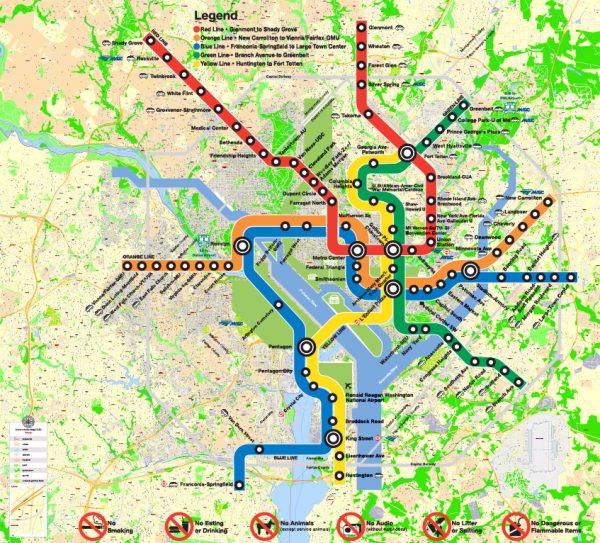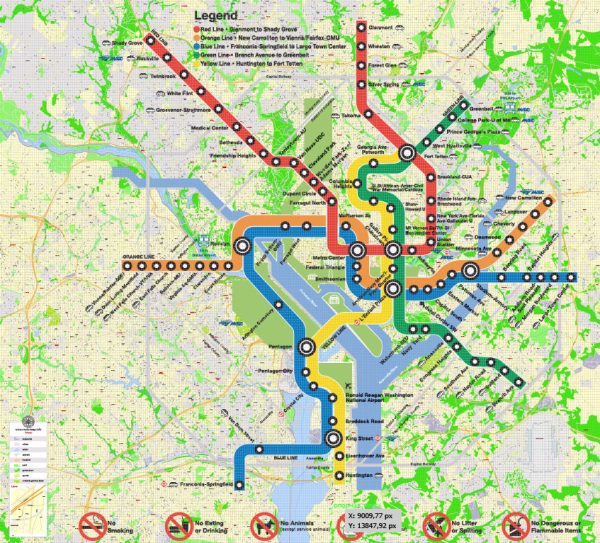Washington, D.C., and Arlington, Virginia, are neighboring areas with distinct histories of urban development. Here’s an overview of the key phases in the urban development of both Washington, D.C., and Arlington:
Washington, D.C.:
- Planning and Establishment (1790):
- Washington, D.C., was established as the capital of the United States in 1790 as part of the Residence Act. Pierre Charles L’Enfant, a French-American engineer, designed the city with a grand plan, featuring wide avenues, parks, and iconic structures.
- Federal Presence:
- The city was designed to reflect the ideals of the new republic, with the Capitol, White House, and the National Mall serving as focal points. The design embodied the principles of neoclassical architecture.
- 19th Century Growth:
- During the 19th century, Washington, D.C., experienced steady growth, with the construction of government buildings, monuments, and residential areas. The city’s population increased as it became a center for politics, administration, and culture.
- Civil War Impact (1861-1865):
- The Civil War had a significant impact on Washington, D.C., as it became a hub for military operations and administration during the conflict.
- Urban Renewal and Development (20th Century):
- The 20th century saw urban renewal projects, including the development of the Federal Triangle, the construction of the National Archives, and the expansion of government facilities.
- Civil Rights Era:
- Washington, D.C., played a central role in the Civil Rights Movement, with historic events such as the March on Washington in 1963, where Martin Luther King Jr. delivered his famous “I Have a Dream” speech.
- Home Rule Act (1973):
- The Home Rule Act in 1973 granted Washington, D.C., greater autonomy in local governance, allowing residents to elect their own mayor and city council.
- Contemporary Development:
- Today, Washington, D.C., is a vibrant city with a mix of historic and modern architecture. It continues to evolve with ongoing development projects, cultural events, and a diverse population.
Arlington, Virginia:
- Early Settlement and Plantations:
- Arlington’s history dates back to the colonial era when it was part of land granted to various individuals. The area was initially known for plantations and agriculture.
- Custis-Lee Estate:
- The Custis-Lee estate, later known as Arlington House, was built by George Washington Parke Custis, the step-grandson of George Washington. It overlooks the Potomac River and became the home of Robert E. Lee.
- Civil War and Arlington National Cemetery:
- During the Civil War, Arlington House and its surrounding grounds were used as a military cemetery. Today, Arlington National Cemetery is a solemn tribute to the nation’s military history.
- Post-Civil War Development:
- After the war, Arlington experienced suburban development. Residential neighborhoods were established, and the area became increasingly connected to Washington, D.C., through bridges and transportation links.
- Federal Presence:
- Arlington’s proximity to Washington, D.C., led to the establishment of federal agencies and military installations, including the Pentagon, which became a major employer in the region.
- Metrorail Expansion (1970s):
- The extension of the Metrorail system to Arlington in the 1970s enhanced transportation connectivity and spurred economic development in the area.
- Pentagon City and Crystal City Development:
- The development of Pentagon City and Crystal City as mixed-use urban centers in Arlington brought commercial, residential, and retail spaces to the region.
- Rosslyn and Ballston Urbanization:
- Rosslyn and Ballston underwent urbanization, with high-rise developments, office buildings, and cultural amenities, making them key business and residential districts.
- Smart Growth Initiatives:
- Arlington has been a pioneer in smart growth initiatives, emphasizing transit-oriented development, mixed-use planning, and environmental sustainability.
- Technology Corridor:
- Arlington has become part of the Northern Virginia technology corridor, attracting technology companies and contributing to the region’s economic growth.
- Cultural and Recreational Spaces:
- Arlington offers a range of cultural and recreational spaces, including parks, theaters, and arts venues, contributing to the area’s quality of life.
Both Washington, D.C., and Arlington, Virginia, have played pivotal roles in American history and continue to be dynamic urban centers. While Washington, D.C., serves as the nation’s capital with a focus on government and culture, Arlington has evolved into a diverse and vibrant urban community with a mix of residential, commercial, and cultural spaces.



 Author: Kirill Shrayber, Ph.D.
Author: Kirill Shrayber, Ph.D.